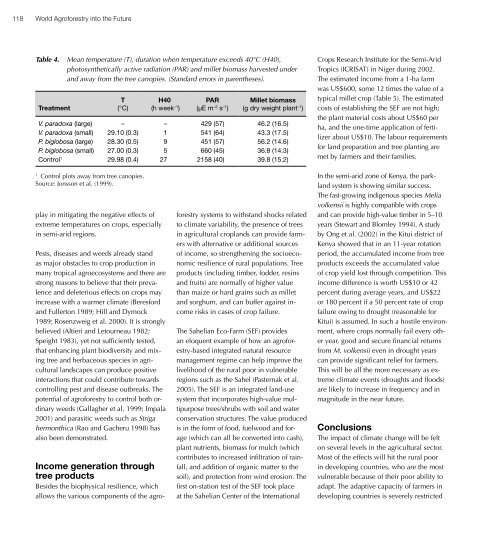The challenge of HIV/AIDS: Where does agroforestry fit in? - World ...
The challenge of HIV/AIDS: Where does agroforestry fit in? - World ...
The challenge of HIV/AIDS: Where does agroforestry fit in? - World ...
Create successful ePaper yourself
Turn your PDF publications into a flip-book with our unique Google optimized e-Paper software.
118<strong>World</strong> Agr<strong>of</strong>orestry <strong>in</strong>to the FutureTable 4.TreatmentMean temperature (T), duration when temperature exceeds 40°C (H40),photosynthetically active radiation (PAR) and millet biomass harvested underand away from the tree canopies. (Standard errors <strong>in</strong> parentheses).T(°C)V. paradoxa (large) –V. paradoxa (small)P. biglobosa (large)P. biglobosa (small)Control 129.10 (0.3)28.30 (0.5)27.00 (0.3)29.98 (0.4)H40(h week –1 )–19527PAR(µE m –2 s –1 )429 (57)541 (64)451 (57)660 (45)2158 (40)Millet biomass(g dry weight plant –1 )46.2 (16.5)43.3 (17.5)56.2 (14.6)36.8 (14.3)39.8 (15.2)Crops Research Institute for the Semi-AridTropics (ICRISAT) <strong>in</strong> Niger dur<strong>in</strong>g 2002.<strong>The</strong> estimated <strong>in</strong>come from a 1-ha farmwas US$600, some 12 times the value <strong>of</strong> atypical millet crop (Table 5). <strong>The</strong> estimatedcosts <strong>of</strong> establish<strong>in</strong>g the SEF are not high;the plant material costs about US$60 perha, and the one-time application <strong>of</strong> fertilizerabout US$10. <strong>The</strong> labour requirementsfor land preparation and tree plant<strong>in</strong>g aremet by farmers and their families.1Control plots away from tree canopies.Source: Jonsson et al. (1999).play <strong>in</strong> mitigat<strong>in</strong>g the negative effects <strong>of</strong>extreme temperatures on crops, especially<strong>in</strong> semi-arid regions.Pests, diseases and weeds already standas major obstacles to crop production <strong>in</strong>many tropical agroecosystems and there arestrong reasons to believe that their prevalenceand deleterious effects on crops may<strong>in</strong>crease with a warmer climate (Beresfordand Fullerton 1989; Hill and Dymock1989; Rosenzweig et al. 2000). It is stronglybelieved (Altieri and Letourneau 1982;Speight 1983), yet not sufficiently tested,that enhanc<strong>in</strong>g plant biodiversity and mix<strong>in</strong>gtree and herbaceous species <strong>in</strong> agriculturallandscapes can produce positive<strong>in</strong>teractions that could contribute towardscontroll<strong>in</strong>g pest and disease outbreaks. <strong>The</strong>potential <strong>of</strong> agr<strong>of</strong>orestry to control both ord<strong>in</strong>aryweeds (Gallagher et al. 1999; Impala2001) and parasitic weeds such as Strigahermonthica (Rao and Gacheru 1998) hasalso been demonstrated.Income generation throughtree productsBesides the biophysical resilience, whichallows the various components <strong>of</strong> the agr<strong>of</strong>orestrysystems to withstand shocks relatedto climate variability, the presence <strong>of</strong> trees<strong>in</strong> agricultural croplands can provide farmerswith alternative or additional sources<strong>of</strong> <strong>in</strong>come, so strengthen<strong>in</strong>g the socioeconomicresilience <strong>of</strong> rural populations. Treeproducts (<strong>in</strong>clud<strong>in</strong>g timber, fodder, res<strong>in</strong>sand fruits) are normally <strong>of</strong> higher valuethan maize or hard gra<strong>in</strong>s such as milletand sorghum, and can buffer aga<strong>in</strong>st <strong>in</strong>comerisks <strong>in</strong> cases <strong>of</strong> crop failure.<strong>The</strong> Sahelian Eco-Farm (SEF) providesan eloquent example <strong>of</strong> how an agr<strong>of</strong>orestry-based<strong>in</strong>tegrated natural resourcemanagement regime can help improve thelivelihood <strong>of</strong> the rural poor <strong>in</strong> vulnerableregions such as the Sahel (Pasternak et al.2005). <strong>The</strong> SEF is an <strong>in</strong>tegrated land-usesystem that <strong>in</strong>corporates high-value multipurposetrees/shrubs with soil and waterconservation structures. <strong>The</strong> value producedis <strong>in</strong> the form <strong>of</strong> food, fuelwood and forage(which can all be converted <strong>in</strong>to cash),plant nutrients, biomass for mulch (whichcontributes to <strong>in</strong>creased <strong>in</strong>filtration <strong>of</strong> ra<strong>in</strong>fall,and addition <strong>of</strong> organic matter to thesoil), and protection from w<strong>in</strong>d erosion. <strong>The</strong>first on-station test <strong>of</strong> the SEF took placeat the Sahelian Center <strong>of</strong> the InternationalIn the semi-arid zone <strong>of</strong> Kenya, the parklandsystem is show<strong>in</strong>g similar success.<strong>The</strong> fast-grow<strong>in</strong>g <strong>in</strong>digenous species Meliavolkensii is highly compatible with cropsand can provide high-value timber <strong>in</strong> 5–10years (Stewart and Blomley 1994). A studyby Ong et al. (2002) <strong>in</strong> the Kitui district <strong>of</strong>Kenya showed that <strong>in</strong> an 11-year rotationperiod, the accumulated <strong>in</strong>come from treeproducts exceeds the accumulated value<strong>of</strong> crop yield lost through competition. This<strong>in</strong>come difference is worth US$10 or 42percent dur<strong>in</strong>g average years, and US$22or 180 percent if a 50 percent rate <strong>of</strong> cropfailure ow<strong>in</strong>g to drought (reasonable forKitui) is assumed. In such a hostile environment,where crops normally fail every otheryear, good and secure f<strong>in</strong>ancial returnsfrom M. volkensii even <strong>in</strong> drought yearscan provide significant relief for farmers.This will be all the more necessary as extremeclimate events (droughts and floods)are likely to <strong>in</strong>crease <strong>in</strong> frequency and <strong>in</strong>magnitude <strong>in</strong> the near future.Conclusions<strong>The</strong> impact <strong>of</strong> climate change will be felton several levels <strong>in</strong> the agricultural sector.Most <strong>of</strong> the effects will hit the rural poor<strong>in</strong> develop<strong>in</strong>g countries, who are the mostvulnerable because <strong>of</strong> their poor ability toadapt. <strong>The</strong> adaptive capacity <strong>of</strong> farmers <strong>in</strong>develop<strong>in</strong>g countries is severely restricted




![MNC_00_Modau [Compatibility Mode].pdf](https://img.yumpu.com/51432208/1/190x146/mnc-00-modau-compatibility-modepdf.jpg?quality=85)











